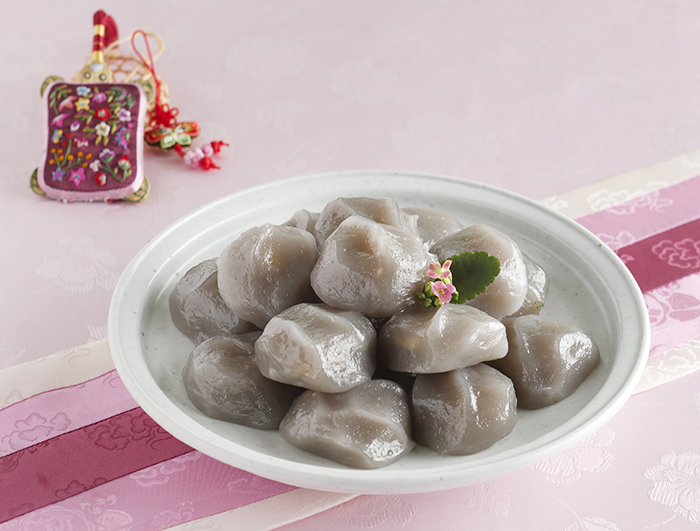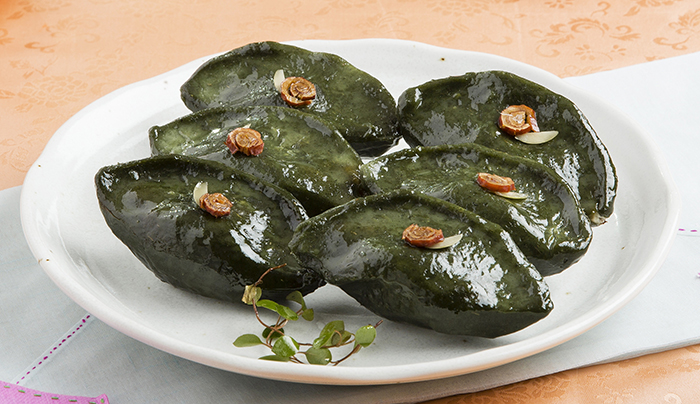View this article in another language
- 한국어
- English
- 日本語
- 中文
- العربية
- Español
- Français
- Deutsch
- Pусский
- Tiếng Việt
- Indonesian
Songpyeon can be made from ingredients other than rice. Potatoes, pumpkins and mosi or ramie leaves can also become wonderful ingredients for songpyeon. One of such variety is gamja songpyeon or potato songpyeon made in Gangwon-do Province, as it offers the chewy and savory taste of potato.
In the upper parts of the Korean Peninsula in Hamgyeong-do Province, people use frozen potatoes as a main ingredient to make songpyeon, as it symbolizes the freezing weather in winter, much colder than Gangwon-do Province.
Though ingredients and recipes for songpyeon may vary, people all across the country enjoy the Chuseok holiday and are thankful for good harvests throughout the year.
[1] Gamja songpyeon from Gangwon-do Province

** Ingredients
200 grams of potato starch powder
2 grams of salt
7 grams of cooking oil
120 grams of boiling water
30 grams of sesame oil
Filling:
20 grams of peas
100 grams of water
30 grams of sugar
20 grams of hedge beans
100 grams of water
30 grams of sugar
20 grams of chestnuts
100 grams of water
30 grams of sugar
12 grams of water with gardenia
** Recipe
1. Wash the peas and hedge beans in water. Soak them in water and sugar.
2. Peel the chestnuts and cut them into six to eight pieces. Soak them in water and sugar.
3. Add the finely ground salt to the potato starch powder and air the mixture by using a strainer.
4. Add the cooking oil and boiling water to the potato powder to make a dough. Grab a handful of dough and fill each piece with the filling.
5. Steam the cakes for 15 minutes in a steamer. Wash the steamed cakes with cold water. Cover the cakes with sesame oil.
[2] Songpyeon made with frozen potatoes, from Hamgyeong-do Province
** Ingredients
200 grams of potato powder
2 grams of salt
7 grams of cooking oil
220 grams of boiling water
30 grams of sesame oil
Filling:
60 grams of red beans
220 grams of water
30 grams of sugar
** Recipe
1. Soak the red beans in water. Remove the peels and steam the red beans in a pot.
2. Melt the frozen potatoes. Grind the potatoes to make a powder. Add salt to the potato powder to make a dough. Knead the dough to make it soft.
3. Add salt and sugar to the steamed red beans. Sift the red bean mixture using a strainer with larger holes to make the filling.
4. Grab a handful of the potato powder dough and make small balls. Put the filling inside the balls and shape them into half moon-shaped cakes. Steam the cakes and cover them with sesame oil.
[3] Mosi Songpyeon

** Ingredients
5 cups of non-glutinous rice
1 tablespoon of salt
300 grams of boiled mosi or ramie leaves
a pinch of salt
a little sesame oil
Filling:
1/2 cup of sesame seeds
2 tablespoons of sugar
1 tablespoon of honey
1/2 cup of peanuts
2 tablespoons of sugar
1 tablespoon of honey
** Recipe
1. Trim the ramie leaves and boil them with a pinch of salt to make them look greener.
2. Wash the rice and soak it for 8 to 12 hours. Grind the rice to make a powder and mix it with salt. Add the ramie leaves to the mixture and grind it all again. Air the mixed powder using a strainer.
3. Fry the sesame seeds and grind them. Crush the peanuts and add sugar, honey and salt to the peanuts. Mix them together to prepare the filling.
4. Make a dough from the rice powder. Grab a handful of dough to make small balls. Put the filling inside each ball to make a small cake. Steam the cakes in a pot for 15 minutes. Cover the cakes with sesame oil.
[4] Hobak songpyeon from Chungcheong-do Province

** Ingredients
5 cups of non-glutinous rice
1 tablespoon of salt
400 grams of sweet pumpkin
Filling:
15 chestnuts
2 tablespoons of honey
1/2 cup of whole sesame seeds
1 tablespoon of honey
100 grams of pine leaves
a little sesame oil
** Recipe
1. Wash the rice three or four times and soak it for 8 to 12 hours. Grind the rice to make a powder and mix it with salt. Air the mixed powder using a strainer.
2. Cut the unpeeled sweet pumpkin into four pieces. Scrape the pumpkin flesh with a spoon. Put the pumpkin flesh into a strainer to sift it.
3. Peel the chestnuts and steam them to make them soft. Mix the chestnuts with honey. Fry the sesame seeds. Grind the fried sesame seeds and mix them with honey. Make small ball fillings.
4. Add the steamed pumpkin to the rice powder and mix it all together. Add the boiling water to the mixture to make a dough. Make the rice balls and put the filling inside to make the songpyeon pieces.
5. Put the rice cakes in a pot with pine leaves. Steam them together by boiling the pot for 15 to 20 minutes. Wash the steamed rice cakes in cold water. Cover the cakes with sesame oil before serving.
Managed by Yoon Sojung
Korea.net Staff Writer
In cooperation with the Institute of Traditional Korean Food (ITKF)
Recipe from “The Beauty of Korean Food: 100 Best-Loved Recipes”
arete@korea.kr
In the upper parts of the Korean Peninsula in Hamgyeong-do Province, people use frozen potatoes as a main ingredient to make songpyeon, as it symbolizes the freezing weather in winter, much colder than Gangwon-do Province.
Though ingredients and recipes for songpyeon may vary, people all across the country enjoy the Chuseok holiday and are thankful for good harvests throughout the year.
[1] Gamja songpyeon from Gangwon-do Province

Gamja songpyeon, or songpyeon made with potato, is popular in Gangwon-do Province. It's made from a potato starch powder filled with red beans or beans. In the city of Gangneung, people leave their handprints on the cakes to give them unique shapes.
** Ingredients
200 grams of potato starch powder
2 grams of salt
7 grams of cooking oil
120 grams of boiling water
30 grams of sesame oil
Filling:
20 grams of peas
100 grams of water
30 grams of sugar
20 grams of hedge beans
100 grams of water
30 grams of sugar
20 grams of chestnuts
100 grams of water
30 grams of sugar
12 grams of water with gardenia
** Recipe
1. Wash the peas and hedge beans in water. Soak them in water and sugar.
2. Peel the chestnuts and cut them into six to eight pieces. Soak them in water and sugar.
3. Add the finely ground salt to the potato starch powder and air the mixture by using a strainer.
4. Add the cooking oil and boiling water to the potato powder to make a dough. Grab a handful of dough and fill each piece with the filling.
5. Steam the cakes for 15 minutes in a steamer. Wash the steamed cakes with cold water. Cover the cakes with sesame oil.
[2] Songpyeon made with frozen potatoes, from Hamgyeong-do Province
** Ingredients
200 grams of potato powder
2 grams of salt
7 grams of cooking oil
220 grams of boiling water
30 grams of sesame oil
Filling:
60 grams of red beans
220 grams of water
30 grams of sugar
** Recipe
1. Soak the red beans in water. Remove the peels and steam the red beans in a pot.
2. Melt the frozen potatoes. Grind the potatoes to make a powder. Add salt to the potato powder to make a dough. Knead the dough to make it soft.
3. Add salt and sugar to the steamed red beans. Sift the red bean mixture using a strainer with larger holes to make the filling.
4. Grab a handful of the potato powder dough and make small balls. Put the filling inside the balls and shape them into half moon-shaped cakes. Steam the cakes and cover them with sesame oil.
[3] Mosi Songpyeon

Mosi songpyeon, or songpyeon made with ramie leaves, is enjoyed in many areas of Jeolla-do and Gyeongsang-do provinces. This songpyeon variety is made from boiled ramie leaves, rice powder dough and sweet fillings made from beans, red beans, chestnuts, jujubes and sesame seeds.
** Ingredients
5 cups of non-glutinous rice
1 tablespoon of salt
300 grams of boiled mosi or ramie leaves
a pinch of salt
a little sesame oil
Filling:
1/2 cup of sesame seeds
2 tablespoons of sugar
1 tablespoon of honey
1/2 cup of peanuts
2 tablespoons of sugar
1 tablespoon of honey
** Recipe
1. Trim the ramie leaves and boil them with a pinch of salt to make them look greener.
2. Wash the rice and soak it for 8 to 12 hours. Grind the rice to make a powder and mix it with salt. Add the ramie leaves to the mixture and grind it all again. Air the mixed powder using a strainer.
3. Fry the sesame seeds and grind them. Crush the peanuts and add sugar, honey and salt to the peanuts. Mix them together to prepare the filling.
4. Make a dough from the rice powder. Grab a handful of dough to make small balls. Put the filling inside each ball to make a small cake. Steam the cakes in a pot for 15 minutes. Cover the cakes with sesame oil.
[4] Hobak songpyeon from Chungcheong-do Province

Hobak songpyeon is made with pumpkin. Pieces of dried pumpkin harvested from the previous winter are used to make a pumpkin powder which is added to the rice powder to make the dough.
** Ingredients
5 cups of non-glutinous rice
1 tablespoon of salt
400 grams of sweet pumpkin
Filling:
15 chestnuts
2 tablespoons of honey
1/2 cup of whole sesame seeds
1 tablespoon of honey
100 grams of pine leaves
a little sesame oil
** Recipe
1. Wash the rice three or four times and soak it for 8 to 12 hours. Grind the rice to make a powder and mix it with salt. Air the mixed powder using a strainer.
2. Cut the unpeeled sweet pumpkin into four pieces. Scrape the pumpkin flesh with a spoon. Put the pumpkin flesh into a strainer to sift it.
3. Peel the chestnuts and steam them to make them soft. Mix the chestnuts with honey. Fry the sesame seeds. Grind the fried sesame seeds and mix them with honey. Make small ball fillings.
4. Add the steamed pumpkin to the rice powder and mix it all together. Add the boiling water to the mixture to make a dough. Make the rice balls and put the filling inside to make the songpyeon pieces.
5. Put the rice cakes in a pot with pine leaves. Steam them together by boiling the pot for 15 to 20 minutes. Wash the steamed rice cakes in cold water. Cover the cakes with sesame oil before serving.
Managed by Yoon Sojung
Korea.net Staff Writer
In cooperation with the Institute of Traditional Korean Food (ITKF)
Recipe from “The Beauty of Korean Food: 100 Best-Loved Recipes”
arete@korea.kr